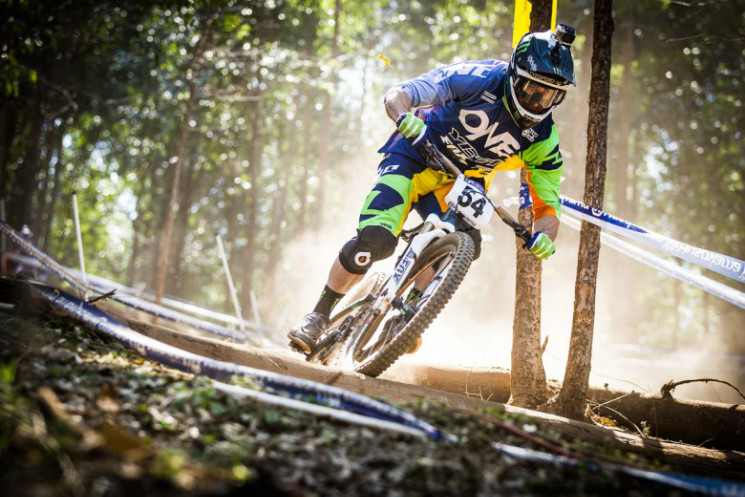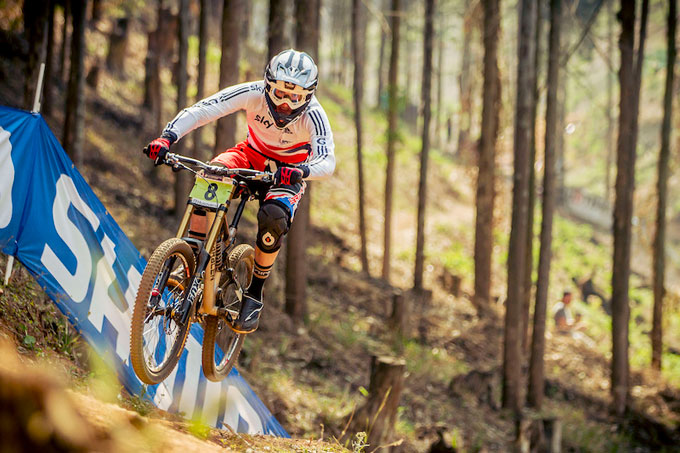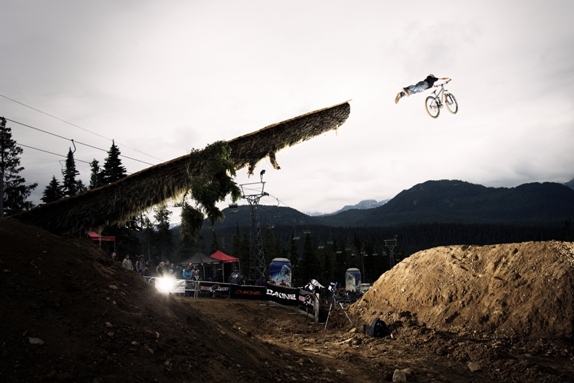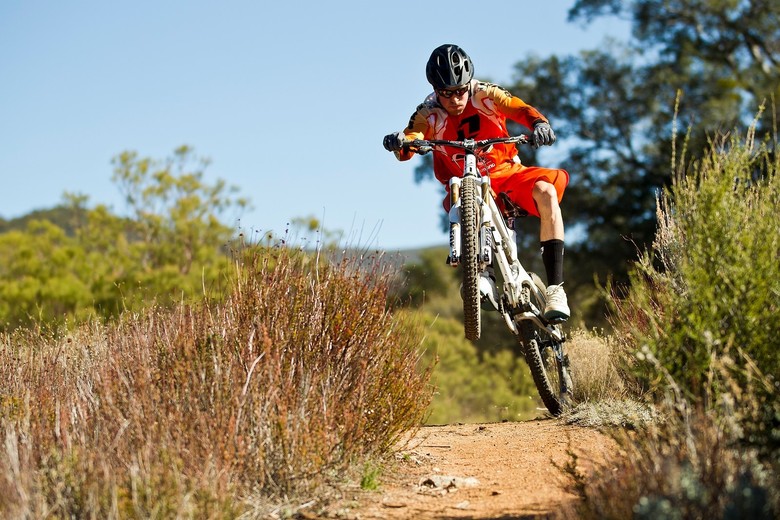Saddle Source
Tuesday, 3 March 2015
Critical Mass London: 27.02.15
Once a month cyclists, skateboarders and scooter users come together for Critical Mass, a protest group aiming to reclaim the streets of London for self-propelled transport.
The Mass has no set route and no set leader, it simply follows the route of whoever happens to be at the front at that time.
Equipped with speaker systems and alcohol, the 2,000 strong band revel in disrupting traffic and attracting the ire of taxi drivers. As it snakes through the city, the mass is cheered and derided in equal measure.
Friday, 20 February 2015
In Defence of PMB
Pietermaritzberg is the track that Internet Warriors and
perennial World Cup under-achievers seem to loath and dread in equal measure.
They fear its dry, dusty, physicality; they run scared from the notorious
motorway section and scoff at the technicality of the increasingly difficult
top section.
Firstly, I think it’s great that a track can generate so
much discussion, it speaks volumes of a community that clearly love their sport
enough to produce the passionate tirades that are ubiquitous across forums and
message boards.
Unfortunately however, I think most of what is said is
unfounded and wrong.
As much of a pity as it is, most of us will never be able to
visit every World Cup race in a year, the viewing figures on the internet are
massive compared to actual live audiences. The tracks that many people are
imagining - rugged hillsides, dense forests and massively steep chutes, simply aren’t
suitable for filming on.
The two best races of recent years were the World Champs of
2011 and Andorra 2013, but the reason they were so good was because a relative
unknown pulled out an unbelievable run to take the win. The actual race footage
itself (minus Rob Warner’s commentary) was quite average, the crews couldn’t even
access the gnarliest bits of the track.
At Pietermaritzberg you get an uninterrupted minute of
footage of the bottom section of the track, watching the riders style it over
the final hip is genuinely great, the same is true of the cable cam shots at
Hafjell.
Frankly, I would take a better viewing experience of the
race live for a majority of the audience at the expense of ‘pure’ downhill,
than risk losing the coverage altogether.
If the coverage of our sport starts to dip so will the
sponsors interest which in turn will lead to a slowing of product development.
If I’m honest I don’t really want every Tom, Dick and Harry joining me at my
local trails, but I do want the sport to remain popular enough for me to drool
over new kit every year.
We also need to think about the tracks themselves. I agree,
there’s nothing better than watching a top rider smash into a loamy berm,
spraying roost wildly before sprinting away, but this simply isn’t sustainable.
Loose, dusty, rutted trails simply can’t stand the abuse of thousands of runs
from the world’s top riders, these guys ride hard!
When a track is changing so much that it makes practice
irrelevant and your results depends massively on where you qualify, it becomes
a pointless exercise. You can’t know who the best in the world is unless they
all ride on a track that’s comparable, with a reliable surface. As odd as it
sounds, a bit of consistency is no bad thing, at least it gives our sport
credibility rather than being an expensive game of Russian roulette on an
uneven playing field.
But what says most about the suitability of Pietermaritzberg
is not looking at who shouts the loudest, but who says nothing at all. Both the
Athertons, Minaar, Gwin and Smith, the sport’s consummate professionals and
champions all keep quiet on the subject, they get their heads down, they train
and they consistently win.
Like it or not, bike park style tracks are becoming part of
mountain biking, and frankly we encourage them by watching and sharing endless
Whistler edits. The complete modern day mountain biker can compete as strongly
and consistently on these tracks as they can on Val di Sole or Andorra, and
that is the bottom line.
Wednesday, 18 February 2015
Tuesday, 10 February 2015
Tuesday, 30 September 2014
The 5 craziest, dust-crushing lines from Red Bull Rampage
There's no doubt that the annual Red Bull Rampage competition produces some crazy riding, but seeing the course from the rider's point of view shows how insane it really is:
5. Kelly McGarry
After some big crashes in qualifying, it's no wonder McGarry sounds so nervous in his finals run.
4. Tom Van Steenbergen
Van Steenbergen's run was cut cruelly short by a big crash on the canyon gap in finals, but this qualifying run shows he had the potential for far more.
3. Brett Rheeder
Many thought that Brett Rheeder's technical and trick-filled run was scored harshly, you be the judge here.
2. Cam Zink
If he hadn't stopped to entertain the crowd, Zink may well have took home the win, check out his insane 360 at 0:50.
1. Andreu Lacondeguy
Andreu rightly took the crown this year, with his run proving that he can hit the Utah dirt harder, faster and bigger than anyone else.
5. Kelly McGarry
After some big crashes in qualifying, it's no wonder McGarry sounds so nervous in his finals run.
4. Tom Van Steenbergen
Van Steenbergen's run was cut cruelly short by a big crash on the canyon gap in finals, but this qualifying run shows he had the potential for far more.
3. Brett Rheeder
Many thought that Brett Rheeder's technical and trick-filled run was scored harshly, you be the judge here.
2. Cam Zink
If he hadn't stopped to entertain the crowd, Zink may well have took home the win, check out his insane 360 at 0:50.
1. Andreu Lacondeguy
Andreu rightly took the crown this year, with his run proving that he can hit the Utah dirt harder, faster and bigger than anyone else.
Tuesday, 16 July 2013
Godsend or just a waste of time?
The man with the world's oddest spelt first name has landed the first ever combo of the world's most confusing trick. For those that haven't seen it, here's Szymon Godziek's Cashroll Barspin
Cashroll Barspin
I take nothing away from this achievement, to name a few records, it's the first ever Cashroll Barspin, on any bike, it's the first ever Cashroll combo on a mountain bike and it's the first time ever that a trick has been performed on a mountain bike before a BMX, but it sits as an odd bedfellow to the shambles of the X Games last weekend. How can Szymon recieve so many plaudits for this historical feat and be described as 'pushing the boundaries of slopestyle', when many other top riders could not even ride the course at X Games, the most exposed event in Slopestye's history? Should riders really be learning to do cashroll barspins when they struggle to ride in the wind?
The problem comes from the definition of Slopestyle and/ or Freeride. Freeride itself comes from snowboarding, and encompasses riding without any goals or a set course, in this sense there is no 'real' freeriding in mountain biking. Perhaps the closest the sport comes to this in the FMB tour is the Rampage, where a an entire mountain side is given over for the riders to express themselves. However, there are still man made features and to succeed riders have to correlate their runs to a specific set of judging guidelines. The element of competition totally removes the idea that the riding in any FMB tour event could ever be truly 'free'.
Slopestyle is a definition that better suits the FMB tour, I have taken this from WIkipedia: "Slopestyle" type riding is an increasingly popular genre that combines big-air, stunt-ridden freeride with BMX style tricks. Slopestyle courses are usually constructed at already established mountain bike parks and include jumps, large drops, quarter-pipes, and other wooden obstacles. There are always multiple lines through a course and riders compete for judges' points by choosing lines that highlight their particular skills".
Cashroll Barspin
I take nothing away from this achievement, to name a few records, it's the first ever Cashroll Barspin, on any bike, it's the first ever Cashroll combo on a mountain bike and it's the first time ever that a trick has been performed on a mountain bike before a BMX, but it sits as an odd bedfellow to the shambles of the X Games last weekend. How can Szymon recieve so many plaudits for this historical feat and be described as 'pushing the boundaries of slopestyle', when many other top riders could not even ride the course at X Games, the most exposed event in Slopestye's history? Should riders really be learning to do cashroll barspins when they struggle to ride in the wind?
The problem comes from the definition of Slopestyle and/ or Freeride. Freeride itself comes from snowboarding, and encompasses riding without any goals or a set course, in this sense there is no 'real' freeriding in mountain biking. Perhaps the closest the sport comes to this in the FMB tour is the Rampage, where a an entire mountain side is given over for the riders to express themselves. However, there are still man made features and to succeed riders have to correlate their runs to a specific set of judging guidelines. The element of competition totally removes the idea that the riding in any FMB tour event could ever be truly 'free'.
 |
| "Freeride" |
Slopestyle is a definition that better suits the FMB tour, I have taken this from WIkipedia: "Slopestyle" type riding is an increasingly popular genre that combines big-air, stunt-ridden freeride with BMX style tricks. Slopestyle courses are usually constructed at already established mountain bike parks and include jumps, large drops, quarter-pipes, and other wooden obstacles. There are always multiple lines through a course and riders compete for judges' points by choosing lines that highlight their particular skills".
This format has allowed the FMB tour to become the most global of all the elite competitions in the mountain biking spectrum, with events varying geographically from the centre of Vienna to the slopes of Whistler bike park. It also means that events are easy and exciting to watch both live and on screen, they are a great introduction to the sport and I'm sure make plenty of money. However on all these factors I can't help but feel that it will never compete with BMX. Most bronze and silver events on the tour are little more than dirt jump contests, whilst the jumps are larger than in BMX, the larger bikes needed to ride them restrict the variety and technicality of tricks that can be performed and furthermore reduce the danger factor for spectators. Furthermore BMX bikes are far cheaper and generally perceived as cooler than jump bikes, until this is changed BMX will be the sport that kids gravitate to more.
The larger events, Crankworx, the X Games, Rampage and Chatel, I feel show the true potential of Freestyle mountain biking, in these events the jumps and drops are significantly larger, there are many lines to pick from and specifically in chatel and rampage the battle to overcome nature is maintained, keeping the 'mountain' in mountain biking. The only problem is, as I mentioned earlier, a lot of riders now aim their training exclusively at the smaller events to the extent of not being able to even ride some of the gnarlier courses, but still being able to compete for the overall series.
This has created a transatlantic divide over where the fmb tour should pitch itself. The Europeans generally favour the dirt jump courses where as the North Americans excell on the big mountain freeride courses.
So where do you stand on this debate? Should freeride play it safe, appeal to the mass markets and allow accessible events for the public and riders? Or should it be an elite form of competition, where only a truly skilled rider can express themselves over a semi natural course?
Personally I believe that the latter of these two options is the best, downhill does not attempt to change it's natural environment to gain a bigger following and it survives as a sport, furthermore, in these days of social media publicising the sport is no longer a problem. But where do you stand? Should there even be 2 separate series? Let me know in the comments below!
Tuesday, 9 July 2013
'Too Enduro'
I've been very quiet on the blog front lately and a lot has happened. 2 World Cups, Atherton domination, last weekend Slopestyle faced possibly it's largest ever exposure in the X-Games and the Enduro World Series ignited in spectacular fashion at Punta Ala, a spark that has continued through Rounds 2 and 3.
As a sport Enduro has shook up the long established order of Mountain Biking. Previously our sport suffered from a polarisation of Cross Country and Downhill, with Dirt Jumping/ 4X being admired but largely ignored by the vast majority of riders. Brief fads, such as All Mountain Riding, existed as interesting concepts but never seemed to have the momentum to really catch on. Enduro, which has capitalised on the increasing popularity of Trail Centre riding, has allowed the vast majority of riders to find a style of riding that suits them.
Cross Country and Downhill racing both require very specialised equipment and skill sets to be proficient, and, furthermore, can only really be enjoyed to their full potential when racing between the tapes against a clock. Everything else is just training, no doubt fun, but lacking the pedal to the metal edge that they really need to attain the biggest rush. For everyone else, those who enjoyed riding trail centres, and perhaps even knew their local trails well enough to link up their favourite descents with relaxed fire road climbs (sound familiar?) there was no way to compete with other riders, beyond Strava, which itself is not without fault. Enduro was born to meet the demand of these riders and it shows in the relaxed competition formats aimed to encourage riders of all abilities and with a vast variety of equipment.
Enduro as a format did not have an easy birth but is now a competition that is emerging on par with the other well established disciplines. Original detractors argued that it was simply a graveyard for Downhillers with a lack of ability and Cross Country riders with a lack of stamina. These arguments have been quashed by dedicated Enduro athletes consistently outperforming riders from other disciplines.
What I find interesting is that through the dedication of Chris Ball and co, other disciplines of Mountain Biking can now benefit. Firstly, on the organisation front, the renegade Enduro World Series has taken just a year to flourish where formats such as DH1 were unable to. Through sheer bloody mindedness and hard work Enduro has managed to escape the bureaucratic shackles of the UCI, it has shown that Mountain Biking does not need an institution, that massively favours Road Cycling, to attract big name sponsors and venues.
Secondly, it allows for a better definition of Downhill and Cross Country, the massive gulf between the two polar opposites of the sport meant for many downhill tracks that were flat and featureless, and Cross Country circuits that led to a majority of riders walking sections. Downhill tracks which are not up to standard can now be described as 'too Enduro' in a way that was simply not expressable until recently. Tracks are now put under more scrutiny, which will lead to harder technical trails and a higher standard of grassroots racing, leading to higher standards of competition and riders in the future.
Finally, trail centres can now be used more widely. No longer will they turn more and more towards the family market and consistently sanitised trails. A market will emerge for technical, Enduro style tracks. Furthermore, as race events sweep the length and breadth of the country new race lines will appear, and the chance to watch and compete with top riders on one's local trails will help to push the standards of trail centre users.
As I mentioned at the start of this blog, 2013 looks like a positive year for the sport of Mountain Biking, the potential displayed in the first three rounds of the Enduro World Series seems to show that the Enduro Evolution has just begun, although hopefully the Euro fashions won't be following along with it!
(Vital MTB)
As a sport Enduro has shook up the long established order of Mountain Biking. Previously our sport suffered from a polarisation of Cross Country and Downhill, with Dirt Jumping/ 4X being admired but largely ignored by the vast majority of riders. Brief fads, such as All Mountain Riding, existed as interesting concepts but never seemed to have the momentum to really catch on. Enduro, which has capitalised on the increasing popularity of Trail Centre riding, has allowed the vast majority of riders to find a style of riding that suits them.
Cross Country and Downhill racing both require very specialised equipment and skill sets to be proficient, and, furthermore, can only really be enjoyed to their full potential when racing between the tapes against a clock. Everything else is just training, no doubt fun, but lacking the pedal to the metal edge that they really need to attain the biggest rush. For everyone else, those who enjoyed riding trail centres, and perhaps even knew their local trails well enough to link up their favourite descents with relaxed fire road climbs (sound familiar?) there was no way to compete with other riders, beyond Strava, which itself is not without fault. Enduro was born to meet the demand of these riders and it shows in the relaxed competition formats aimed to encourage riders of all abilities and with a vast variety of equipment.
Enduro as a format did not have an easy birth but is now a competition that is emerging on par with the other well established disciplines. Original detractors argued that it was simply a graveyard for Downhillers with a lack of ability and Cross Country riders with a lack of stamina. These arguments have been quashed by dedicated Enduro athletes consistently outperforming riders from other disciplines.
(Matt Wragg)
What I find interesting is that through the dedication of Chris Ball and co, other disciplines of Mountain Biking can now benefit. Firstly, on the organisation front, the renegade Enduro World Series has taken just a year to flourish where formats such as DH1 were unable to. Through sheer bloody mindedness and hard work Enduro has managed to escape the bureaucratic shackles of the UCI, it has shown that Mountain Biking does not need an institution, that massively favours Road Cycling, to attract big name sponsors and venues.
Secondly, it allows for a better definition of Downhill and Cross Country, the massive gulf between the two polar opposites of the sport meant for many downhill tracks that were flat and featureless, and Cross Country circuits that led to a majority of riders walking sections. Downhill tracks which are not up to standard can now be described as 'too Enduro' in a way that was simply not expressable until recently. Tracks are now put under more scrutiny, which will lead to harder technical trails and a higher standard of grassroots racing, leading to higher standards of competition and riders in the future.
Finally, trail centres can now be used more widely. No longer will they turn more and more towards the family market and consistently sanitised trails. A market will emerge for technical, Enduro style tracks. Furthermore, as race events sweep the length and breadth of the country new race lines will appear, and the chance to watch and compete with top riders on one's local trails will help to push the standards of trail centre users.
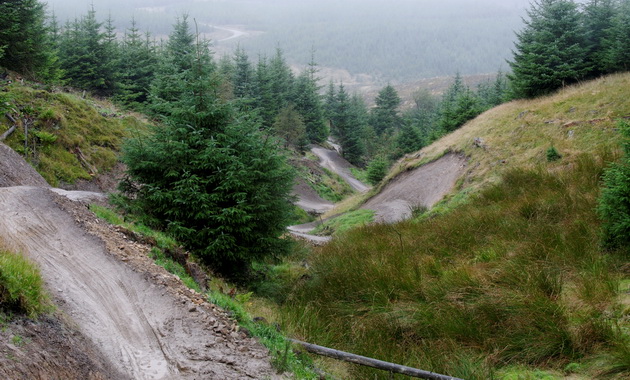 |
| Hully Gully, Trail Centre Perfection (PMBA.org) |
As I mentioned at the start of this blog, 2013 looks like a positive year for the sport of Mountain Biking, the potential displayed in the first three rounds of the Enduro World Series seems to show that the Enduro Evolution has just begun, although hopefully the Euro fashions won't be following along with it!
Subscribe to:
Posts (Atom)
